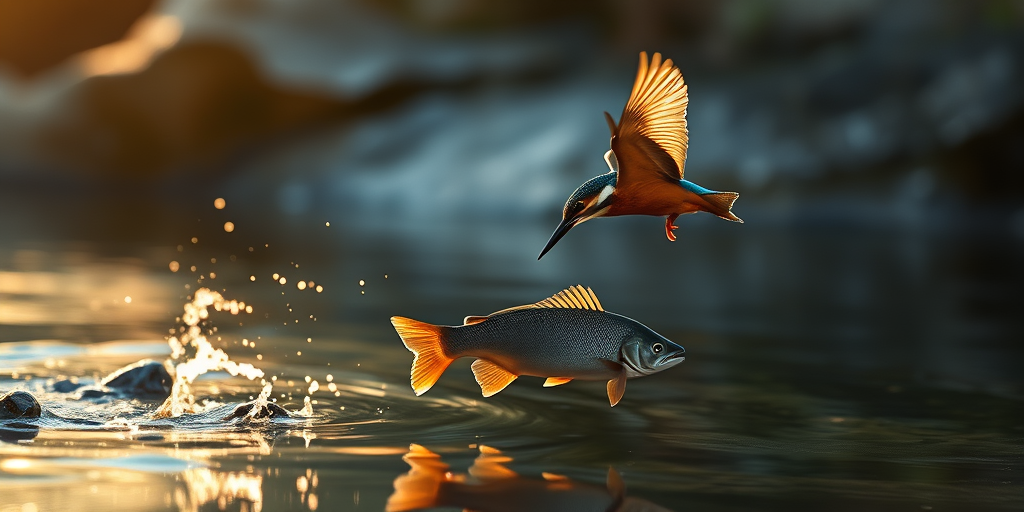Is it possible to witness an avian marvel that combines dazzling speed, razor sharp hunting skills, and significant conservation relevance? The Kingfisher, a visually striking waterbird celebrated for its iridescent plumage and rapid flight, exemplifies nature’s impeccable design. Its adaptive prowess enables survival across varied habitats, highlighting its ecological impact. This article examines the bird’s impressive speed and precise hunting tactics while addressing the urgent conservation actions ensuring its continued legacy.
The Kingfisher: High-Speed Flight and Diving Dynamics
The Kingfisher exhibits remarkable acceleration, employing bursts of speed that propel it into rapid aerial maneuvers before commencing its dive. Its streamlined body and dynamic wing configuration contribute to a high‐speed descent, allowing precise targeting of underwater prey. A specialized nictitating membrane acts as a protective shield during the transition from air to water. This combination of factors not only facilitates an ultrafast freefall dive but also ensures that every movement is optimized for efficiency and accuracy as the bird navigates between two distinct environments.
- Acceleration: Rapid increase in speed during flight initiation
- Maneuverability: Quick adjustments to wing position for precise aerial maneuvering
- Protection during dive: Use of a nictitating membrane to safeguard its eyes
- Water entry effectiveness: Streamlined body design minimizes splash and turbulence
The flight mechanics of the Kingfisher exemplify a system perfected through evolutionary refinement, integrating powerful bursts of speed with meticulous control over direction. Each dive is orchestrated with calculated precision that minimizes energy loss, while the bird’s anatomical features guarantee successful penetration of water surfaces. This exquisite balance of avian velocity and dive expertise supports its role as an adept predator, contributing to the regulation of aquatic populations and the maintenance of ecological balance.
The Kingfisher: Conservation Efforts and Habitat Safeguarding
Kingfishers confront mounting challenges from human-induced habitat loss, water pollution, and climate change that compromise their hunting grounds and nesting habitats. The degradation of shoreline ecosystems not only restricts their range but disrupts the balance of fish populations, an essential component of aquatic biodiversity. These environmental pressures compel a reevaluation of conservation tactics and provoke an unwavering commitment to ecosystem preservation plans. Ecological research has underscored the importance of adapting conservation policies to protect these sensitive bird populations.
- Protecting wetland habitats
- Pollution monitoring
- Establishing wildlife support programs
- Promoting sustainable environmental policies
In response to these challenges, targeted conservation actions have been implemented across multiple regions. Wildlife support programs now integrate scientific research with active habitat management, enabling precise shoreline ecosystem research and the refinement of conservation policy reform. Environmental care campaigns and ecosystem preservation initiatives work in tandem to bolster the resilience of Kingfisher habitats. This strategic blend of monitoring, policy adaptation, and habitat safeguarding aims to secure the ecological role of Kingfishers, ensuring their continued contribution to balanced fish populations and broader biodiversity. The ongoing nature of these efforts reflects the avian community’s dedication to preserving natural systems for future generations.
Final Words
in the action, the article outlines the Kingfisher’s vibrant appearance, rapid aerial maneuvers, precise hunting techniques, and committed conservation actions.
The discussion briefly covers its striking iridescence, swift water entries, and strategic perching while stressing the need for habitat safeguarding and community involvement in conservation measures.
The Kingfisher: Speed, Hunting, and Conservation exemplifies nature’s dynamic elegance and serves as a call to support ecological balance.
Readers gain insights and motivation to engage actively with environmental preservation efforts.
FAQ
How do kingfishers hunt their prey?
A: Kingfishers hunt by perching motionless above water, spotting fish beneath the surface, then executing a high-speed vertical dive to catch prey with their sharp beaks.
What is the success rate of kingfisher hunting?
A: Kingfishers achieve a 60% success rate in hunting attempts, making them among the most effective avian predators. Their precise diving technique and specialized vision contribute to this efficiency.
How do kingfishers protect their eyes while diving?
A: Kingfishers possess a specialized nictitating membrane that acts as protective goggles, allowing clear underwater vision while preventing eye damage during high-speed water entry.
What adaptations help kingfishers catch fish?
A: Kingfishers have compact bodies, dagger-like beaks, and extraordinary vision that can compensate for light refraction in water, making them exceptional fish hunters.
Where do kingfishers typically build their nests?
A: Kingfishers construct tunnel-like nests in riverbanks, digging burrows up to 3-6 feet deep. These tunnels slope upward to prevent flooding and protect eggs.
What threats do kingfishers face in the wild?
A: Kingfishers face significant challenges from water pollution, habitat destruction, and climate change impacts on their aquatic hunting grounds and nesting sites.
How many species of kingfishers exist?
A: There are over 90 kingfisher species worldwide, ranging from tiny hummingbird-sized varieties to larger specimens like the giant kingfisher.
What do kingfishers eat besides fish?
A: Kingfishers consume small fish, amphibians, aquatic insects, and crustaceans. Some species also hunt lizards and small snakes in terrestrial habitats.


